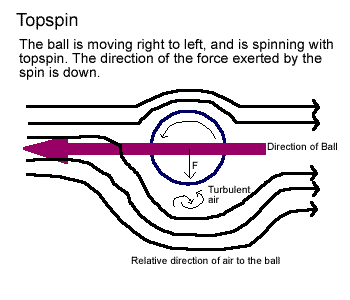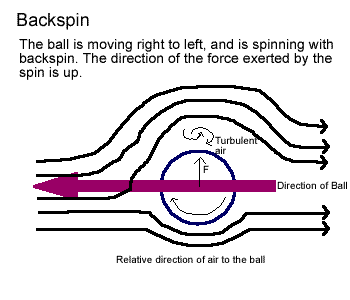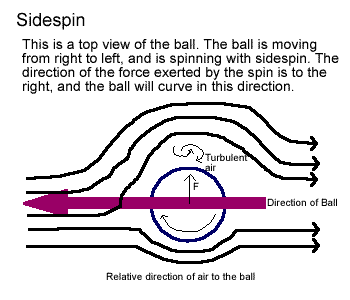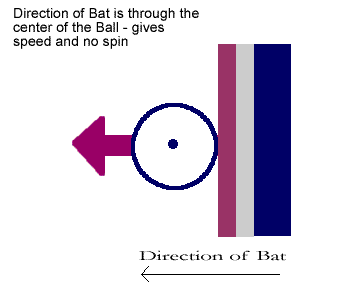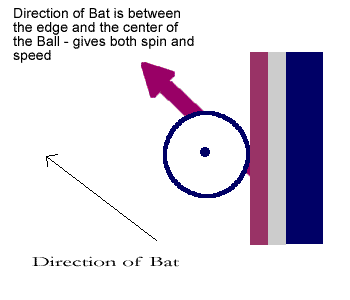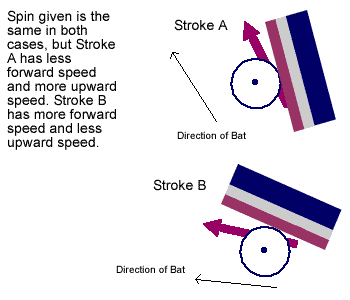Without getting too much into the science behind it all, in effect the spin on the ball puts a force on the ball which is at right angles to the direction it is moving. This force will affect the flight of the ball.
There are three main spins to understand in table tennis:
- Topspin
- Backspin
- Sidespin
We will be examining all three of these spins, as well as taking a look at how to create your own spin when playing table tennis, and how different strokes can create varying amounts of spin and speed. But first, here’s a video of mine which showcases the effect of the different spins on the flight of the ball, and what happens when they hit your racket.
Topspin – How does it Work?
|
|
With topspin, the ball is rotating forward so that the top of the ball is moving in the same direction that the ball is travelling. The force exerted on the ball by its spin will be generally downwards (assuming the ball has been hit almost horizontally). This downward force works in the same direction as gravity, causing the ball to dip faster towards the table.
It is the effect of topspin that allows advanced players to hit the ball with amazing power from below the net, but still land the ball on the other side of the table. |
Backspin – How does it Work?
|
|
With backspin, the bottom of the ball is moving in the same direction that the ball is travelling. The force exerted on the ball by its spin will be generally upwards (again, assuming the ball has been hit almost horizontally). This upward force works in the opposite direction to gravity, causing the ball to drop more slowly.
Since a table tennis ball is light and easily slowed by air, a heavy backspin stroke performed from several feet from the table will often slow down it’s forward speed quite noticeably over the opponent’s side of the table, then slowly fall onto the playing surface. This ‘stop and drop’ effect is used by defenders when playing against topspin attacks. |
Sidespin – How does it Work?
|
|
When sidespin is applied, the force on the ball will be parallel to the ground and towards the left or right side. The ball will drop at the same speed as a no-spin ball, but it will curve to the left or the right in the air.
Sidespin can be combined with either topspin or backspin to produce a moving ball that is acted on by a combination of both forces. A ball with topspin and sidespin will drop faster and curve to the left or right, while a ball with backspin and sidespin will tend to drop slowly and curve at the same time. It’s not possible to put both types of sidespin on the ball, or topspin and backspin at the same time (if you can, please let me know how!). |
How Do You Create Spin?
I’ve written in some detail below about the differences between hitting the ball with no spin, heavy spin and low speed, and with both spin and speed. But first, I’d suggest watching this 6 minute video that will make the explanation below clearer.
How Do You Create Spin? A No-Spin Stroke.
|
|
Spin is applied to the ball by brushing or skimming the ball instead of making square contact. Think of a line going straight out from the bat in the direction the rubber surface is travelling. If the line goes through the center of the ball when the ball is struck, maximum speed will be given and no spin will be applied. The closer the line is to the edge of the ball, the more spin will be put on the ball, and the less speed. In practice, the line is always somewhere in between these two extremes, giving more spin and less speed the closer the line is to the edge of the ball.
The diagram illustrates the first case, where the ball is struck squarely by the rubber surface, with the direction of motion of the bat going straight through the center of the ball. No spin will be applied by this stroke, but a lot of speed will be given. |
How Do You Create Spin? A High-Spin Stroke.
|
|
The diagram illustrates the second extreme, where the direction of motion of the rubber surface is almost at the edge of the ball. This stroke will produce a heavy spin on the ball, but not much speed. |
How Do You Create Spin? Combining Spin and Speed.
|
|
The diagram shows what will happen when the direction the rubber surface is travelling is in between the center and the edge of the ball. The closer the line to the edge of the ball, the more spin will be given and the less speed , and the closer the line to the center of the ball, the more speed will be given and the less spin.
This means that for the same amount of bat speed, you can generate completely different amounts of spin and speed on the ball, just by varying the way you contact the ball. |
How Do You Create Spin? Keeping the Spin the Same While Changing Speed.
|
|
By adjusting the direction the rubber surface travels vertically or horizontally, you can also change the horizontal speed of the ball. The diagram above shows two strokes that would produce the same speed and spin on the ball. They will not appear to be the same to the opponent though.
Stroke A is a more upward stroke, and will give a return that has more upward speed and less forward speed. The opponent will see this as a slower, high topspin. Stroke B is a more forward stroke, and will give a return that has more forward speed and less upward speed. The opponent will see this as a faster, low topspin. Remember that both balls are equally spinny. So this means that a ball that is coming at you faster and lower is not necessarily less spinny than a ball that is coming slower and higher. Tricky stuff!
|
Learning to Loop for Beginners
Given that the loop is such an important shot in table tennis, the process of learning to put heavy topspin on the ball is vital to your progress. Here’s a short video explaining a terrific drill that will help you learn correct looping technique and contact quickly.
Now that you know how spin works and how to create your own, let’s move on to how to use spin properly.

